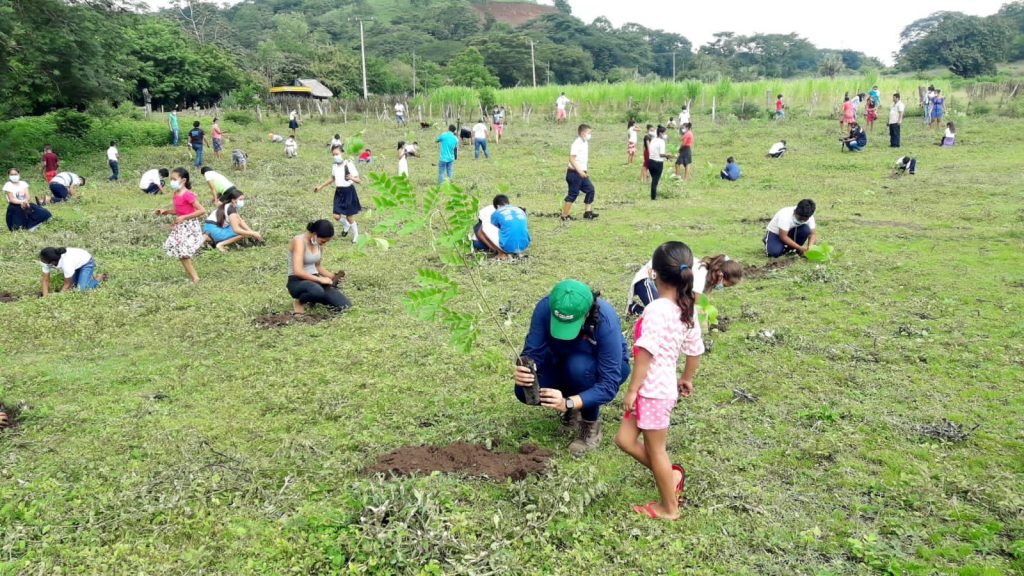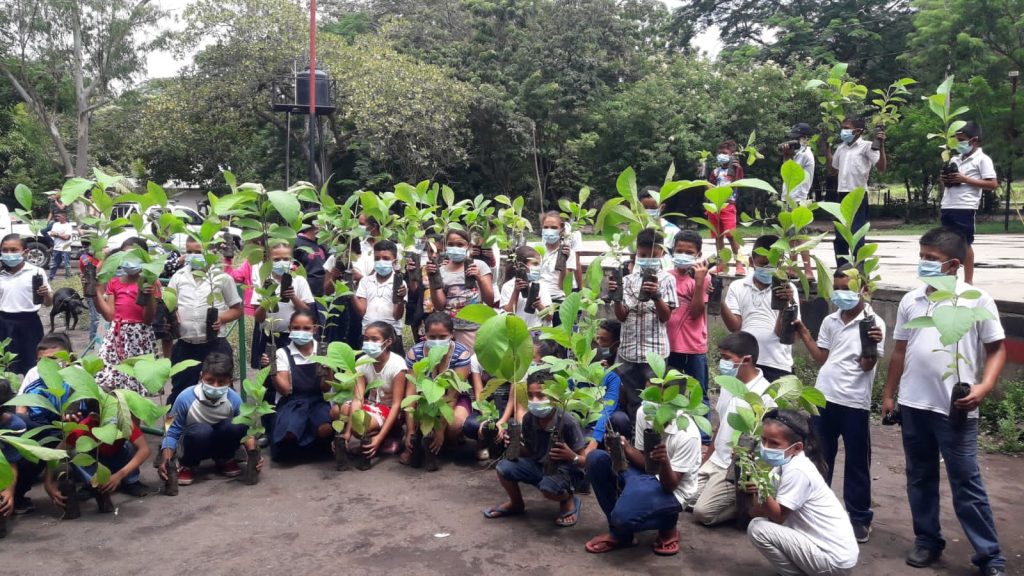Collaboration among different organisations helps to leverage resources when adapting to the changing climate. Plan International collaborated with a private company and the municipality of El Viejo, Chinandega in Nicaragua with the aim to help strengthen the communities’ natural capital base and establish a common understanding that together we can achieve more than by ourselves.
Joining forces in Chinandega
Plan International is a member of the Zurich Flood Resilience Alliance and implements the “Increasing Flood Resilience in Central America” project in four communities in El Viejo, Chinandega, Nicaragua. Plan International’s flood resilience work in Nicaragua is guided by the Flood Resilience Measurement for Communities (FRMC) approach.
Plan works collaboratively with the private company Ingenio Pantaleón, which cultivates sugar cane and produces sugar for export, and the municipality of El Viejo, Chinandega on various projects, amongst others, on reforesting degraded areas in Plan’s project-communities. This three-fold collaboration was set up to merge resources and knowledge while working towards the same goal: sensitize and work with the communities to restore and protect the natural environment.
Each of the organisations could have worked on reforestation on its own, but they decided to join forces to generate a greater and longer lasting impact. Through reforestation, Plan and the involved organisations aim to contribute to the protection and conservation of the natural environment.
Deforestation and its link to flood resilience
The FRMC baseline study showed that the deforestation in the area, a common issue, is linked to changes in land use. People cut down trees to plant grain crops and mangroves are cut down to set up shrimp farms. Finally, families cut plants and trees to collect wood for cooking.
Deforestation is linked to floods as it decreases the vegetation cover, increases runoff and the speed with which floods hit the communities – ultimately increasing the potential for damage. This is especially the case in areas where the water flows from more elevated areas and then hits less elevated areas where the communities are often located. In the intervention areas, the degradation of the forest resource is evident. In areas where there were woods before, there are crops now. Therefore, a high percentage of families are aware of the need to implement actions aimed at protecting the natural environment and to reduce the degradation of soil and ecosystems.

Besides restoring the natural capital, reforestation helps to reduce the impact floods have on communities, as the plants act as natural barriers, thereby addressing the resilience gap that is caused by decreased vegetation. This project is linked to another project by Plan, in which efficient cooking stoves are handed out to vulnerable community members. Those cooking stoves use 50% less wood than traditional ones, because they are built in such a way that they use the heat more efficiently. In that way, they help to reduce the consumption of firewood and, hence, deforestation. By reforesting the natural environment and reducing wood consumption, the vegetation around the communities can recover.
A collaborative effort
As part of its Corporate Social Responsibility Strategy, Ingenio Pantaleón, partnered with Plan to work on activities that benefit the communities that live in the areas around the sites in which the company operates. Since Plan already had a lot of experience working with the communities, it was a perfect match. The involved actors identified that establishing community nurseries and reforesting the area would contribute to the recovery of the natural capital. Ingenio Pantaleón therefore committed a budget of C$40,000 per year to implement those actions.
Each of the organisations contributed their unique skills and resources to the following activities to establish the community nurseries and carry out the reforestation days:
- The municipality trained the community members how to establish the nurseries.
- Ingenio Pantaleón provided soil, sand and organic matter to grow the seedlings.
- Community members helped with filling the bags (with soil and seeds), watered and took care of them.
- Finally, Plan coordinated the project, provided further tools and trainings and carried out various awareness raising activities.
- In addition, the National Forest Institute provided polyethylene bags, in which the seedlings are grown and the seeds for growing them, and the Ministry of Natural Resources provided compost.

Four community nurseries (one per community) were established. Around 20’000 plants were grown that way in one year (across the 4 communities), including fruit trees, which not only reforest the area, but also contribute to a healthy diet (which is important because access to fresh fruits is rather limited in the communities due to their remoteness). A part of those plants was planted by carrying out reforestation days which are organised by Plan and the Local Committee for Disaster Prevention and Response (COLOPRED). The whole community is invited to voluntarily participate in planting the plants. Another part of the plants is handed out to farmers, landowners and other community members, so that they can plant the plants on their own.
Members from community-based groups helped to choose the sites for planting, as they know their communities best and know where the water usually passes during floods. The plants can then act as natural barriers against the floods. Besides planting trees, Plan carries out awareness raising activities (through presentations and workshops) during the reforestation days to highlight the importance of conserving the natural capital to increase flood resilience.
I recommend continuing working on this project, as the community was integrated, the families were integrated, the municipal committee, Plan Nicaragua, the municipality, Ingenio Pantaleón, the National Forestry Institute as well. Many organisations were integrated into this project and helped us to realize the work. Some of us contributed with the seeds, others gave the soil, others planted the plants, and the children bagged the plants. Thus, it was very collaborative work.
Alba Alarcón, teacher in the community of Kilaca

Moreover, in this case, it integrated different organisations that are active in the area and provided an opportunity to collaborate and to grow closer together. Ingenio Pantaleón and the municipality are looking at possibilities to replicate Plan’s activities in other communities beyond the project areas. If you want to learn more about this intervention, take a look at this video.
A message from Plan International
“It is with deep sadness to inform you that we have very recently had to end our operations in Nicaragua. Decisions to leave a country are never taken lightly. However, we have reached a point where it was effectively impossible to continue operating as an independent, humanitarian NGO working to advance children’s rights and equality for girls. The evolving regulatory context in Nicaragua has made it increasingly difficult for us to ensure the safety of both the children, youth and families we work with, and our staff. In the end, we were left with no other choice.
We have been in Nicaragua since 1994 and have worked tirelessly to advance children’s rights and equality for girls, reaching more than 400 communities. We are sincerely grateful to all the communities, partners, and institutions that have placed their trust in us, enabling us to carry out our purpose in support of children for so many years. Our mission remains alive through the impact we have made together.”

Comments